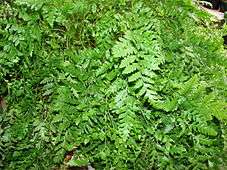Rumohra adiantiformis
Rumohra adiantiformis, the leather fern or leatherleaf fern,[1][2] is a species of fern in the wood fern family Dryopteridaceae. It has a wide distribution, mainly in the tropical Southern Hemisphere.
| Rumohra adiantiformis | |
|---|---|
 | |
| Scientific classification | |
| Kingdom: | Plantae |
| Clade: | Tracheophytes |
| Class: | Polypodiopsida |
| Order: | Polypodiales |
| Suborder: | Polypodiineae |
| Family: | Dryopteridaceae |
| Genus: | Rumohra |
| Species: | R. adiantiformis |
| Binomial name | |
| Rumohra adiantiformis | |
Names
Other common names include leathery shieldfern,[3] iron fern,[4] 7-weeks-fern,[5] and climbing shield fern.[6]
Description
Growing to 90 cm (35 in) tall and broad, Rumohra adiantiformis is a bushy, tufted evergreen plant with glossy dark green fronds. These contain round sori (reproductive clusters) on the underside of the pinnae (leaflets) unlike many other ferns which have separate specialized reproductive fronds. Many of the sori have protective peltate indusia (films), and prominent scales on the stipes of the fronds.
Distribution
Rumohra adiantiformis is native to South America, the Caribbean, southern Africa, the Western Indian Ocean islands, Papua New Guinea, and Australasia.[1] Countries it is native to include such diverse places as Brazil and Colombia,[7] the Galápagos Islands,[8] the Greater Antilles in the Caribbean, Zimbabwe and South Africa[1] Australia, and New Zealand.
Ecology
An example of plant associations of Rumohra adiantiformis is found in the podocarp/broadleaf forests of Westland, New Zealand, with flora associates including Ascarina lucida, Pseudowintera colorata, Pseudopanax colensoi, Cyathea smithii and Blechnum discolor.[9]
Cultivation
The fern is cultivated as an ornamental plant for groundcover and in floristry.[2] As it is a tropical plant with only limited protection against frost, in temperate climates it is normally grown under glass as a houseplant. In the UK it has gained the Royal Horticultural Society’s Award of Garden Merit.[10][11]
It is of economic importance in Brazil, where thousands of people generate their income by wild-harvesting and selling the fronds for use in flower arrangements.[5]
References
- U.S. National Plant Germplasm System; GRIN-Global Web v 1.9.7.1: Taxonomy profile of Rumohra adiantiformis
- Gilman, E. F. Rumohra adiantiformis. Fact Sheet FPS-515. University of Florida Cooperative Extension, IFAS. 1999.
- Rumohra adiantiformis. Flora of Tasmania.
- Rumohra adiantiformis. USDA PLANTS.
- De Souza, G. C., et al. (2006). An ethnobiological assessment of Rumohra adiantiformis (samambaia-preta) extractivism in Southern Brazil. Biodiversity & Conservation 15(8), 2737-46.
- Rumohra adiantiformis. Museum of New Zealand Te Papa Tongarewa, Wellington.
- Gonzalez Castiblanco, G. P. 2004. Factibilidad de exportacion de follaje de helecho de cuero (Rumohra adiantiformis) para ramos o adornos frescos. Pontificia Universidad Javeriana, Bogota, Colombia, Facultad de Ingenieria, 134 pages.
- Wiggins, I. L. Flora of the Galápagos Islands. Stanford University Press. 1971. 998 pages ISBN 0-8047-0732-4, ISBN 978-0-8047-0732-9
- Hogan, C. M. 2009. Crown Fern: Blechnum discolor Archived 2012-02-13 at the Wayback Machine Globaltwitcher.com, ed. N. Stromberg.
- "Rumohra adiantiformis". Retrieved 11 October 2018.
- "AGM Plants - Ornamental" (PDF). Royal Horticultural Society. July 2017. p. 93. Retrieved 11 October 2018.
External links
| Wikimedia Commons has media related to Rumohra adiantiformis. |
- Friday Fellow: Leatherleaf Fern at Earthling Nature.
